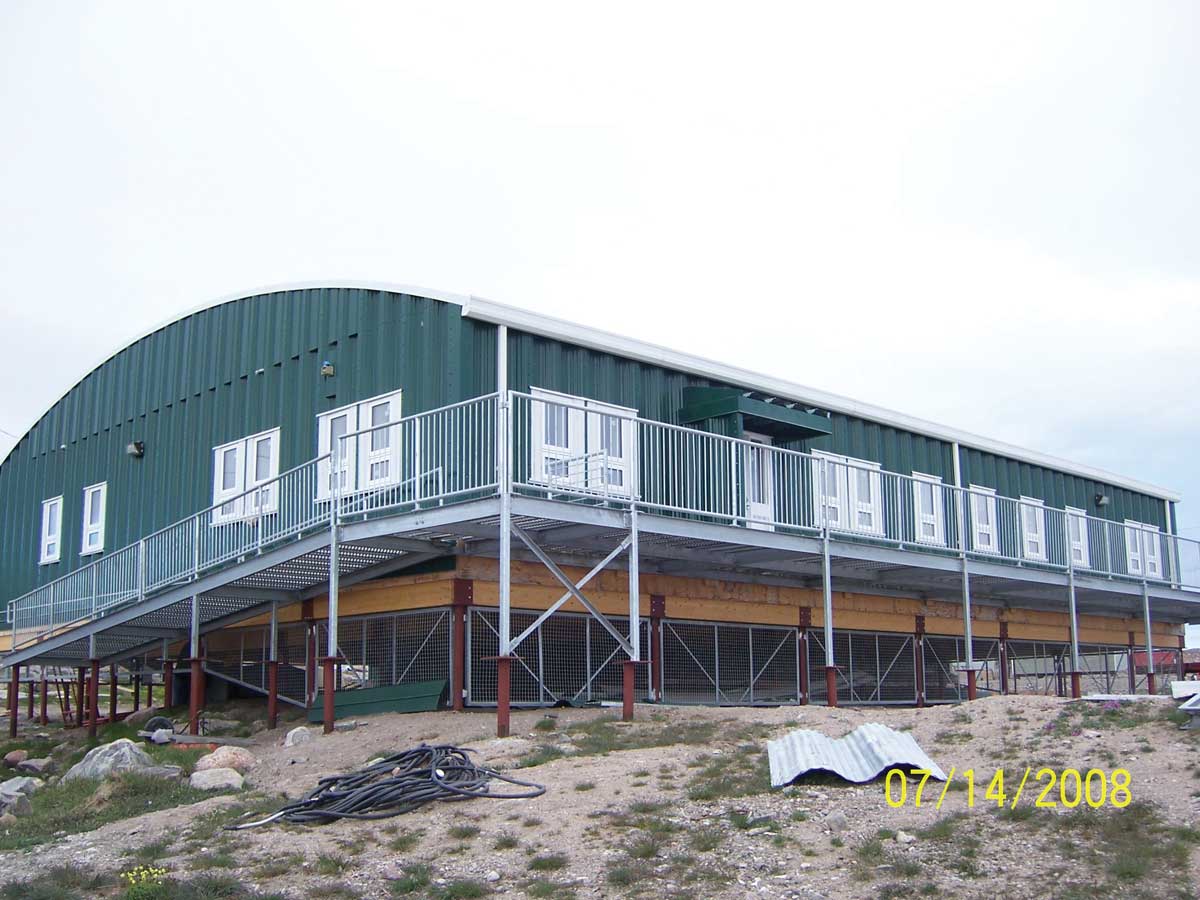By Mark Halsall

Industry experts talk about the challenges of construction in logistically demanding locations in northern Manitoba
As anyone who’s worked in the industry knows, there are always challenges that arise in construction. In remote locations in Manitoba’s north, the construction challenges can be quite daunting – and can run the gamut from the logistical puzzle of getting equipment and materials to places with no road access, to how to ward off polar bears.
Zac Penner is the general manager of T.L. Penner Construction Inc., a Virden-based company that’s been taking on building projects in northern Manitoba for close to 60 years.
“It comes and goes, but when there are opportunities up there, we’ll go after them,” said Penner, who is the third generation running the family-owned general contracting firm. “We have a history of working in the north, so we know what’s involved.”
That history started in the late 1950s when Penner’s grandfather cleared bush for the first Manitoba Hydro transmission line out of Gilliam, a small town situated more than 1,000 kilometres north of Winnipeg.
Since then, the company has constructed dozens of projects including schools, housing developments and other buildings in Gillam and other remote communities like Nelson House and Fox Lake.
According to Penner, some firms are reluctant to venture to isolated communities because of the uncertainties involved in northern construction.
“If you don’t have the experience or the track record or that sort of thing, it can be a big challenge…Lots of companies really just aren’t set up with the proper management and crews to go out and tackle some of those complicated remote projects,” said Penner. “We’ve done lots of successful work in the North, and it’s something I think we can be proud of.”
Penner says the biggest thing about building in northern Manitoba is that it costs more.
“There’s definitely a construction premium that you have to pay in the North. For one thing, most of the supplies are non-local, and most of the specialized trades are generally coming out of Winnipeg or the Winnipeg area,” he said.
“There are lots of mobilization costs and room and board costs. You also pay more money buying materials locally, or if you don’t and you have to haul materials up there, you’re paying a premium for that,” said Penner, adding that another cost consideration is the amount of fuel that’s needed to keep things operational during the often frigid cold of northern Manitoban winters.
Penner notes that having adequate supplies as well as back-up systems in place can help keep a lid on costs.
“Any mistake that’s made on a remote project is always costlier just because of the fact that it’s remote, especially if you have to remobilize crews or bring in more equipment or materials,” he said.
Penner believes having experienced crews and sound project management can help minimize mistakes.
“When working in the North, you need a good, solid supervisor who can successfully co-ordinate the trades and the schedule,” he said. “Another thing is making sure you’re dealing with reputable trades that also have experience working in the North and know what the challenges are. That sort of thing definitely goes a long way.”
Opportunity to expand market
Drew Halliday is a production superintendent with Flynn Canada. The construction company – which specializes in building envelopes and is part of the Flynn Group of Companies that has 35 locations across North America with offices in Brandon and Winnipeg – performs about five or six jobs in northern Manitoba each year.
“We do quite a bit work in Flin Flon, The Pas, Thompson and the Gilliam area,” said Halliday, who is based out of Flynn Canada’s Brandon office. “It’s very important for us. It definitely opens up a bigger market and gives us more opportunities to keep workers busy.”
Halliday says many of these projects, such as the re-roofing of the Ruth Betts Community School that Flynn Canada is doing in Flin Flon this summer, are bigger, high profile jobs, which in itself is rewarding for the company.
According to Halliday, getting construction materials and equipment up to remote locations can be a huge issue, especially to communities without road access.
“Doing your research is important, making sure you know what’s involved in getting your guys and material and equipment up there,” he said. “You have to make sure that you have all [the] information you need to make the project go smoothly.”
Halliday recommends that construction managers travel to the communities themselves to scout things out, rather than relying only on the phone: “It’s easier if you go up there in person and talk to people.”
Another important consideration, Halliday adds, is finding the right people who can manage having to spend extended periods away from their homes. That’s because most northern projects require at least some skilled tradesmen and other workers to come in from Winnipeg or other southern Manitoba locations, he says.
Finding lodging for these workers can be another test.
“There are only so many places for accommodation up there, and they do tend to fill up fairly quickly,” said Halliday. He adds his company has had some luck renting cabins and even houses for crews when other lodging isn’t available.
While there are challenges for crews on northern construction projects, there are also perks. Halliday maintains many workers enjoy experiencing the rugged wilderness and pristine beauty of Manitoba’s north, and one aspect of it in particular.
“The fishing – the [workers] love that part of it,” he said.
Benefits of hiring locally
Crane Steel Structures, one of Western Canada’s largest builders of metal building systems, has Manitoba locations in Brandon and Headingley. Ed Gramiak, the company’s business and development manager, says about 35 per cent of their work in the province comes from northern jobs.
Currently, Crane Steel Structures is working on two projects for First Nations communities in the North, in The Pas and Pukatawagan. Both are steel buildings being erected for water treatment facilities. The company recently completed four steel structures on the Lake St. Martin reserve in the northern Interlake region.
Gramiak cites transportation challenges as one of main difficulties of building in the North. There’s the cost of flying workers into and out of the jobsite – round-trip flights from Thompson to Winnipeg cost around $1,200 and it costs more the further north you go – and freight charges are always an issue because of the distances materials and equipment typically need to be shipped, Gramiak says.
“In a lot of cases, you’re going on winter roads, which again is more challenging,” he said.
Gramiak agrees with Penner and Halliday that being prepared is the key to success when working in remote locations.
“You always need to have extra material, that’s a must. And a back-up plan for when your equipment fails,” said Gramiak.
Another key, he adds, is finding good workers who aren’t daunted by the rigours of working the North. That’s one of the reasons Gramiak’s company tries to hire locally when it can.
“I don’t think there’s been a job where we haven’t [used] local people on it,” he said. “It sometimes means you have to train them how to do the work, and that’s all part of working in the North.”
Gramiak believes hiring locally also enables the company to give back to the places that provide the construction opportunities.
“If you can engage people that live there, to have them be involved in the project, to work there and to be part of the crew, that’s a good thing for the community,” he said. “That’s probably one of the most rewarding things about it.”
Churchill construction challenges
The town of Churchill, Man., has been struggling since the loss of its rail service – and main supply line – in May 2017. Numerous construction projects have been put on hold because of the prohibitive cost of shipping materials by air to the remote port on the shores of Hudson’s Bay.
However, one project – major renovations to a recreation facility just outside of Churchill – will be resuming this summer thanks to some generous contributions from local supporters.
Louise Lawrie is chair of the Churchill Joint Group Committee, a community organization that oversees the Girl Guides and Boy Scouts organizations and has raised funds for the latest renovations to a Second World War era installation now known as Camp Nanuq. A dormitory is being rebuilt following renovations to a dining hall and a fieldhouse activity hall in recent years.
Lawrie says the cost to transport the required building materials to Churchill by cargo plane will total $15,000. If the rail line was still running, it’d be less than half of that.
Lawrie says her group also looked at having the materials sent by sealift through Montreal. While a less expensive option than air transport, the materials would still need to get from Manitoba to Montreal first and then they wouldn’t arrive in Churchill until much later in the year.
“We have a short window for construction during the summer period. One of the things that we found… with sealift is that things didn’t get here until the fall and our construction season is pretty well over by that time,” she said.
Lawrie points out that a winter road connecting Churchill to Gillam was built and utilized for the first time this past winter, but only a limited number of supplies were able to make it into the community.
In addition to restricted access, Churchill has other construction challenges. For one, it, like many northern communities, has a limited supply of construction workers.
“When a company from, say, Winnipeg bids on a construction job up here, they have to incorporate the travel and the accommodation and the food costs for the people that they would bring in because our community doesn’t have that many tradespeople,” said Lawrie. “It really increases the cost.”
Churchill has another construction challenge faced by few other communities – polar bears.
“At outside construction sites, there will often be a polar bear guard hired, because when people are working, they’re not paying attention necessarily to what’s around them,” said Lawrie. “It’s not unusual to see somebody with a gun who is keeping an eye on things.”


Cover photo by chbaum / 123RF Stock Photo
Above photos by T.L. Penner Construction Inc.




